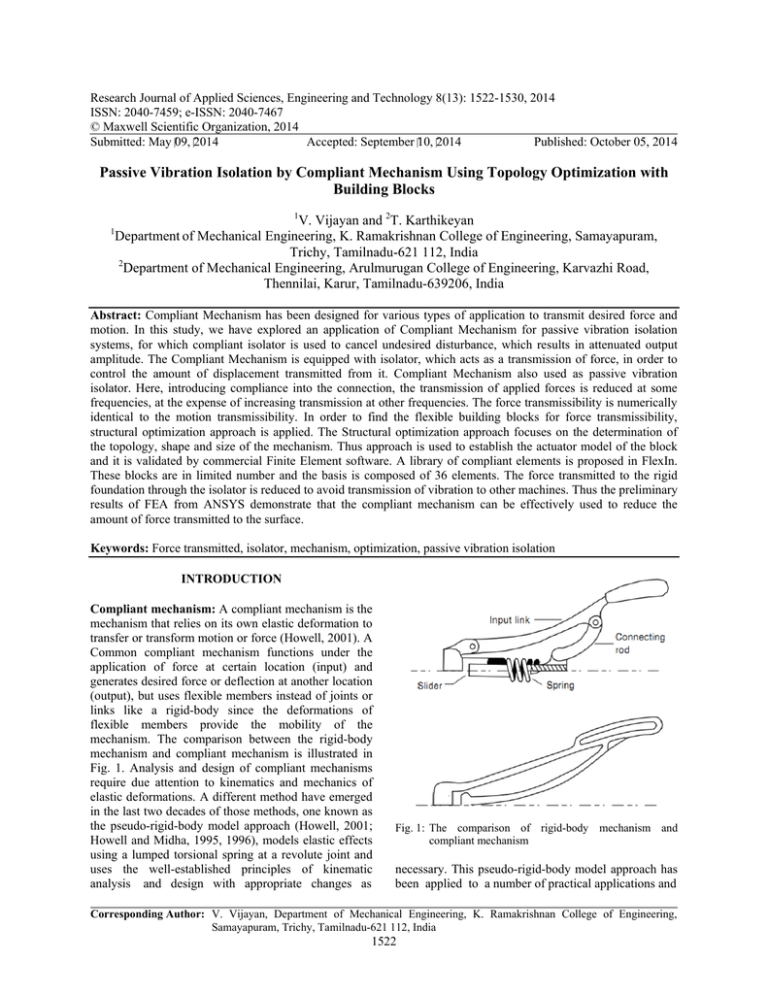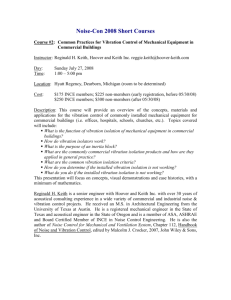Research Journal of Applied Sciences, Engineering and Technology 8(13): 1522-1530,... ISSN: 2040-7459; e-ISSN: 2040-7467
advertisement

Research Journal of Applied Sciences, Engineering and Technology 8(13): 1522-1530, 2014 ISSN: 2040-7459; e-ISSN: 2040-7467 © Maxwell Scientific Organization, 2014 Submitted: May 09, 2014 Accepted: September 10, 2014 Published: October 05, 2014 Passive Vibration Isolation by Compliant Mechanism Using Topology Optimization with Building Blocks 1 V. Vijayan and 2T. Karthikeyan Department of Mechanical Engineering, K. Ramakrishnan College of Engineering, Samayapuram, Trichy, Tamilnadu-621 112, India 2 Department of Mechanical Engineering, Arulmurugan College of Engineering, Karvazhi Road, Thennilai, Karur, Tamilnadu-639206, India 1 Abstract: Compliant Mechanism has been designed for various types of application to transmit desired force and motion. In this study, we have explored an application of Compliant Mechanism for passive vibration isolation systems, for which compliant isolator is used to cancel undesired disturbance, which results in attenuated output amplitude. The Compliant Mechanism is equipped with isolator, which acts as a transmission of force, in order to control the amount of displacement transmitted from it. Compliant Mechanism also used as passive vibration isolator. Here, introducing compliance into the connection, the transmission of applied forces is reduced at some frequencies, at the expense of increasing transmission at other frequencies. The force transmissibility is numerically identical to the motion transmissibility. In order to find the flexible building blocks for force transmissibility, structural optimization approach is applied. The Structural optimization approach focuses on the determination of the topology, shape and size of the mechanism. Thus approach is used to establish the actuator model of the block and it is validated by commercial Finite Element software. A library of compliant elements is proposed in FlexIn. These blocks are in limited number and the basis is composed of 36 elements. The force transmitted to the rigid foundation through the isolator is reduced to avoid transmission of vibration to other machines. Thus the preliminary results of FEA from ANSYS demonstrate that the compliant mechanism can be effectively used to reduce the amount of force transmitted to the surface. Keywords: Force transmitted, isolator, mechanism, optimization, passive vibration isolation INTRODUCTION Compliant mechanism: A compliant mechanism is the mechanism that relies on its own elastic deformation to transfer or transform motion or force (Howell, 2001). A Common compliant mechanism functions under the application of force at certain location (input) and generates desired force or deflection at another location (output), but uses flexible members instead of joints or links like a rigid-body since the deformations of flexible members provide the mobility of the mechanism. The comparison between the rigid-body mechanism and compliant mechanism is illustrated in Fig. 1. Analysis and design of compliant mechanisms require due attention to kinematics and mechanics of elastic deformations. A different method have emerged in the last two decades of those methods, one known as the pseudo-rigid-body model approach (Howell, 2001; Howell and Midha, 1995, 1996), models elastic effects using a lumped torsional spring at a revolute joint and uses the well-established principles of kinematic analysis and design with appropriate changes as Fig. 1: The comparison of rigid-body mechanism and compliant mechanism necessary. This pseudo-rigid-body model approach has been applied to a number of practical applications and Corresponding Author: V. Vijayan, Department of Mechanical Engineering, K. Ramakrishnan College of Engineering, Samayapuram, Trichy, Tamilnadu-621 112, India 1522 Res. J. Appl. Sci. Eng. Technol., 8(13): 1522-1530, 2014 For damped system transmissibility: 𝑇𝑇 = � 𝑅𝑅 2 1+ 2 𝑄𝑄 𝑅𝑅 2 (1−𝑅𝑅 2 )2 + 2 𝑄𝑄 1 𝑄𝑄 = 2𝐶𝐶 ⁄𝐶𝐶𝐶𝐶 R= fn (1) (2) The level of isolation achieved depends on the ratio: Fig. 2: Mounted through isolators is also extended beyond planar applications to spatial (Rasmussen et al., 2006) and spherical linkages (Krishnan et al., 2012). Newer approaches are now emerging where in building blocks are used to develop compliant designs (Lusk and Howell, 2008). Topology optimization: In this type homogenization design method is adopted. Homogenization based topology optimization (Bendsøe, 1989; Burn and Tortorelli, 2001) is the basis for the design technique proposed in this study. Topology and size optimization methods are used to design compliant mechanism. The design procedure followed is size optimization of the beam-element abstraction derived from the continuum topology solution. The topology optimization problem is formulated as a problem of finding the optimal distribution of materials (Li et al., 1998) in an extended fixed domain where some structural cost function is maximized. This work of topology optimization is carried out by using ANSYS (Ding, 1986), therefore by using ANSYS the optimum material distribution is obtained (Bendsoe and Kikuchi, 1988). The structural optimization is obtained by using flexible building blocks (Nastac and Leopa, 2008) designed by FlexIn Corporation and these elements are arranged using trail and approximation method in such a manner to reduce the amount of force transmitted. In order to test the Stability of optimized structure, the stability analysis is done. The stability analysis in compliant mechanism (Rao, 2009) design is of utmost importance. From a practical point of view, a compliant mechanism is unstable of no significance. A system is said to be stable, if the system is subjected to a bounded input or disturbance and the response is bounded in magnitude. Vibration isolation: Vibrations are produced in machines having unbalanced masses. These vibrations will be transmitted to the foundation upon which the machines are installed. It is usually undesirable, to diminish the transmitted forces. The machines are usually mounted on springs or dampers (Fig. 2), or on some other vibration isolation material. Vibration Isolation reduces the level of vibration transmitted to or from a machine or building or structure from another source. fe (3) where, fe = Frequency of disturbing vibration fn = Natural frequency of isolator Transmissibility: >1 = Increased transmitted vibration = 1 = No vibration isolation < 1 = Vibration isolation If no damping is present in isolators i.e., C/Cc = 0. Vibration Control involves the correct use of a resilient mounting or material in order to provide a degree of isolation between a machine and its supporting construction. A condition should be achieved where the amount of vibration transmitted from the machine, or to the machine is at an acceptable level. To achieve efficient vibration isolation it is necessary to use a flexible support with sufficient elasticity, so that the natural frequency f n of the isolated machine is substantially lower that the disturbing frequency f e of vibration. The relation f e /f n should be better than 1.4 and ideally better than 2 to 3 in order to achieve a significant level of vibration isolation. Problem formulation: Compliant mechanism is the focus of active research because of the stability, robustness and ease of manufacturing endowed by their unitized construction. In this study, we explore an application of compliant mechanism for vibration isolation system with rigid foundation. Structural optimization approach is focused on the determination of the topology, shape and size of the mechanism. The building blocks are used to optimize a structure for force transmission. METHODOLOGY Displacement amplitude of the coil spring isolator is obtained for varying frequency ratios R (1.5-5), for 1523 Res. J. Appl. Sci. Eng. Technol., 8(13): 1522-1530, 2014 corresponding displacement amplitude force transmitted to the rigid foundation is determined. Then by using topology optimization and flexible building blocks vibration isolator is designed. The design is subjected to harmonic analysis of FEA by using ANSYS software. The displacement amplitude and force transmission of this design is calculated and the isolation efficiency of the coil spring isolator and compliant mechanism is determined and compared. Design of compliant mechanism using topology optimization and building blocks for vibration isolation: The problem was defined for linear elastic analysis and the material properties were defined (Young's modulus, Poisson's ratio and material density). Then the element 2D plane 2 type was selected for topological optimizations to generate the finite element model. Load and boundary conditions for a single load case linear structural static analysis is shown in Fig. 3. Fig. 3: Meshed design domain Fig. 4: After 10% of volume reduction 1524 Res. J. Appl. Sci. Eng. Technol., 8(13): 1522-1530, 2014 Fig. 5: After 50% of volume reduction Table 1: Specifications for topology optimization Design domain Young’s modulus Poisson’s ratio Input force Upper limit of design variable Lower limit of design variable 500×305×165 mm 200 GPa 0.29 85 kN 10 mm2 0.1 mm2 Figure 4 and 5 illustrates the force transfer path for structural size of 500 mm width and 165 mm height based on volume constraints for the specific load of 85 kN. The optimized path for the transfer of maximum force was obtained using topology optimization. Topology optimization for vibration isolator using FEA: In this example, the boundary condition specified as all the corners of the design domain is fixed and a point load is applied at the middle of the bottom face. The material property, the design variable and domain dimension are given below in Table 1. Compliant building blocks: The design of compliant mechanism is made as an assembly from basic building blocks chosen in a given library. A library of passive compliant elements is proposed in FlexIn. These blocks are composed of 36 elements as shown in Fig. 6. Creation of building blocks from library: A library of passive compliant elements, made of piezoelectric beams, has been implemented in FlexIn. As for passive blocks, a block stiffness matrix is constituted by the assembly of beam stiffness matrices in the global coordinate system. The blocks present some various topologies. Their advantage is that they can furnish multiple coupled Degrees of Freedom (DoFs), thus generate more complex movements with only one building block. These blocks are sufficient to constitute a high variety of topologies and it has been verified that they can describe many existing compliant structures of the literature. Moreover, the block feasibility related to fabrication process constraints is also taken into account at this stage, which is not the case for classical beam-based optimization approaches. From the library of passive compliant building blocks, a structure is formed for optimal distribution of the material. The distribution path for force transmission is determined using topology optimization. Figure 7 illustrates the use of flexible passive compliant building blocks in which the path of maximum force transmissibility occur. Proposed approach of compliant mechanism in passive vibration isolation: Compliant mechanism is designed for Passive Vibration Isolation System (PVIS) as shown in Fig. 8. In this system the existing element, the coil spring isolator, is replaced with the newly designed element in order to reduce the amount of force transmitted to the ground or to the foundation of the machine which tends continuously to damage the base over longer period of time. This happens because initial starting of the machine gives rise to huge amplitude, up to frequency ratio 1 and this region is identified as amplification region. During this amplification region the large amount of vibration force is transmitted. By reducing the force transmitted to the surface, the life of base or foundation of the machine is increased. 1525 Res. J. Appl. Sci. Eng. Technol., 8(13): 1522-1530, 2014 Fig. 6: Library of compliant building blocks for planar compliant mechanisms synthesis using flexin Fig. 7: Structural optimization of isolator using flexible building blocks Fig. 8: Models illustrating the concept of using a compliant mechanism in vibration isolation The scope of this study is limited to low frequency isolation as the use of compliant mechanism in active vibration isolation systems has the greatest advantage in the low frequency range. Since many passive systems are effective and sufficient for high frequency isolation, the need of active systems for high frequency isolation is less than that of low frequency isolation. We also focus on understanding the effects of the compliant design parameters and attempt to solve problems systematically. The preliminary results of FEA from ANSYS demonstrate the effective use compliant mechanism to reduce the amount of force transmitted to 1526 Res. J. Appl. Sci. Eng. Technol., 8(13): 1522-1530, 2014 Fig. 9: A finite element model of compliant mechanism Table 2: Properties of the model used in finite element analyses Element type 2D elastic beam, 2D mass Number of elements 37 elastic beam elements 1 mass element attached at 17th node Young’s modulus 200×109 pa Poisson’s ratio 0.3 Density 7860 kg/m3 Cross section 305 mm width×4 mm thickness Overall dimension 500×165 mm the surface. Figure 8 illustrates integration of compliant mechanism into a vibration isolation system. To achieve efficient vibration isolation it is necessary to use a resilient support with sufficient elasticity so that the natural frequency (f n ) of the isolated machine should be substantially lower than that of the disturbing frequency (f e ) of vibration. The ratio fe/fn should be greater than 1.4 and ideally greater than 2 to 3 in order to achieve a significant level of vibration isolation. Damping provides energy dissipation in a vibrating system. It is essential to control the potential high levels of transient vibration and shock, particularly if the system is excited at, or near, to its resonant frequency. When it is not possible to prevent or sufficiently lower the transmission of shock and vibration from the source a resiliently supported, foundation block can be used for the passive isolation of sensitive equipment. The existing coil spring isolator (FSL coil spring isolator): Farrat Isolevel Ltd. (FSL) Coil Spring Isolation systems are used to provide both active and passive vibration isolation with natural frequencies down to 3 Hz to isolate disturbing frequencies down to 6 Hz. In this preliminary study, existing coil spring isolator is used to reduce the force transmitted from the machine. The model shown in Fig. 9 is designed to withstand the load range from 85-28 kN and constant K ranges from 3.4 to 1.12 kN/mm, free height of the structure is 165 mm and static deflection due to the selfweight of the load is δst-25 and 8 mm for corresponding maximum and minimum load. The compliant mechanism is assumed to be made of structural steel. The gravity and structural damping are ignored for these preliminary analyses. The motion of output is contributed by displacement controlled input. The properties of model are listed in Table 2. Material selection for compliant mechanism: Material for this compliant mechanism is selected based Eq. (4) to (7) on the Young’s modulus which includes natural frequency and area moment of inertia and mass and also cross sectional area of compliant beam. Following equations are used for material selection. Natural frequency of compliant mechanism: ωn = � k (4) m Material constant: k= 192EI l3 = mω2n (5) Young’s modulus of the material is: 1527 E= mω2n l 3 192I (6) Res. J. Appl. Sci. Eng. Technol., 8(13): 1522-1530, 2014 Table 3: Selection of material using young’s modulus Dimension mm Young’s modulus E N/m2 305×3 278×109 305×4 209×109 305×5 107×109 305×6 60×109 305×7 35×109 Fig. 10: 2D-compliant isolator design Fig. 12: Amplitude for different frequency ratio with constant damping ratio ζ = 0.3 Fig. 11: 3D-compliant isolator design Area moment of inertia: I= bh 3 (7) 12 Size of the designed isolator is -500×305×165 mm. From the given maximum load of 85 kN the maximum mass acting on the isolator is m = 8500 kg and material constant k = 3400 N/mm. By varying the dimension of width and height of the isolator, using area moment of inertia, thickness of the compliant beams are determined. In this the width of the isolator is 305 mm. The Table 3 shows the selection of material using different Young’s modulus. Here the optimum range of dimension is 305×4 mm which is having a Young’s modulus of 209×109 N/m2. The required range of E value is around 200 Gpa. Figure 10 and 11 shows the two dimensional and three dimensional, respectively for the suggested optimum range of dimensions. HARMONIC ANALYSIS The harmonic response analysis solves the timedependent equations of motion for linear structures undergoing steady-state vibration. The entire structure has constant or frequency-dependent stiffness, damping and mass effects. All loads and displacements vary sinusoidally at the same known frequency. Element loads are assumed to be real (in-phase) only. Harmonic response of FSL coil spring isolator: Initially the displacement amplitude (Fig. 12) is Fig. 13: Force transmitted for ratio, R corresponding frequency calculated for various frequency ratios from (1.5-5) for damping ratio ζ = 0.3 of coil spring isolator. The force transmitted (Fig. 13) for the corresponding amplitude and frequency ratios are also calculated. Displacement amplitude: Displacement amplitude is calculated using the static displacement Eq. (8), frequency ratio and damping ratio: X δst = 1 �(1−R 2 )2 +(2ζR)2 (8) Force transmitted: Force transmitted for the corresponding displacement amplitude is calculated using known material constant and damping coefficient, it is taken as ζ = 0.3 for maximum value and natural frequency of the coil spring isolator: FT = X�(k 2 + c 2 ω2 ) (9) Harmonic response of compliant isolator: The displacement amplitude (Fig. 14) is calculated for various frequency ratios from 0-7.5 with damping ratio ζ = 0.3 for compliant mechanism using ANSYS. The 1528 Res. J. Appl. Sci. Eng. Technol., 8(13): 1522-1530, 2014 0.50 0.45 VALU 0.40 0.35 0.30 0.25 0.20 0.15 0.10 0.05 0 1.6 0 0.8 3.2 4.8 4.0 FREQ 2.4 8.0 6.4 5.6 7.2 Fig. 16: Force transmitted for varying frequency ratio Fig. 14: Displacement amplitude for corresponding frequency ratio ranges from R, (0-7.5) for compliant mechanism 1.1 (×10**-2) 1.0 VALE 0.9 0.8 0.7 0.6 0.5 0.4 0.3 0.2 0.1 2.4 1.6 2.0 3.2 2.8 5.6 4.8 4.0 3.6 FREQ 4.4 5.2 Fig. 15: Displacement amplitude for corresponding frequency ratio ranges from R, (1.5-5) for compliant mechanism Fig. 17: Isolation efficiency vs. frequency ratio Isolation efficiency: Isolation Efficiency η in percent transmission is related to Transmissibility as: η = 100 (1-Tr)% force transmitted (Fig. 15) for the corresponding amplitude and frequency ratios are also calculated. Isolation efficiency of the existing isolator and designed compliant mechanism is compared (Fig. 17). Displacement amplitude: Displacement amplitude is calculated for compliant mechanism for varying frequency ratios from (1.5-5). CONCLUSION Compliant Mechanism are proposed to provide cost effective and high performance vibration isolation Force transmitted: The force transmitted (Fig. 16) for systems. Their function is to transmit the force for the corresponding amplitude and frequency ratios are various displacement amplitude of corresponding also calculated by using the Eq. (9). frequency ratios. The preliminary results from FEA using ANSYS show that a compliant mechanism can DISCUSSION provide effective vibration isolation from a sinusoidal disturbance with known frequency ratios. Transmissibility ratio: The force transmitted by using In this study the Compliant Mechanism, using compliant mechanism is compared with the existing harmonic analysis, it is demonstrated that when the isolator with constant damping ratio ζ = 0.3. The disturbance is 0.01 m amplitude, the isolation efficiency sinusoidal foundation motion at amplitude x, the is 56% at 1.5 Hz. Whereas, in coil spring isolator the absolute value of the mass response amplitude y isolation efficiency is 30% for corresponding amplitude expressed as a ratio |y/x|, is the Transmissibility: and frequency ratio. Similarly when the disturbance is 0.001 m amplitude, the isolation efficiency is 98% at 5 Transmissibility Ratio Tr = (Force transmitted in Hz. whereas, in coil spring isolator the isolation kN/ Disturbing force in kN) 1529 Res. J. Appl. Sci. Eng. Technol., 8(13): 1522-1530, 2014 efficiency is 93% for corresponding amplitude and frequency ratio. Hence the amount of force transmitted to the surface is identically lower in compliant mechanism than the coil spring isolator. NOMENCLATURE δst k m X c ω ωn I L R η Tr FT E = Static deflection, mm = Stiffness, N/m2 = Applied mass, kg = Displacement amplitude. M = Damping coefficient = Forcing frequency, rad/sec = Natural frequency, rad/sec = Area moment of inertia = Length of strip = Frequency ratio = Isolation efficiency = Transmissibility ratio = Force transmitted, kN = Young’s modulus, GPa REFERENCES Bendsøe, M.P., 1989. Optimal shape design as a material distribution problem. Struct. Multidiscip. Optim., 1: 193-202. Bendsoe, M.P. and N. Kikuchi, 1988. Generating optimal topologies in structural design using a homogenization method. Comput. Method. Appl. M., 71: 197-224. Burn, T.E. and D.A. Tortorelli, 2001. Topology optimization of non-linear elastic structures and compliant mechanisms. Comput. Method. Appl. M., 190: 3443-3459. Ding, Y., 1986. Shape optimization of structures: A literature survey. Comput. Struct., 24: 985-1004. Howell, L., 2001. Compliant Mechanisms. Wiley, New York. Howell, L. and A. Midha, 1995. Parametric deflection approximations for end-loaded, large-deflection beams in compliant mechanisms. J. Mech. Des-T. ASME, 117: 156-165. Howell, L. and A. Midha, 1996. A loop-closure theory for the analysis and synthesis of compliant mechanisms. J. Mech. Des-T. ASME, 118: 121-125. Krishnan, G., C. Kim and S. Kota, 2012. Building block method: A bottom-up modular synthesis methodology for distributed compliant mechanisms. J. Mech. Sci., 3: 15-23. Li, Y., B. Chen and N. Kikuchi, 1998. Topology optimization of mechanism with thermal actuation. Proceeding of the 4th International Conference on ECO Materials. Gifu, Japan. Lusk, C.P. and L.L. Howell, 2008. Components, building blocks, and demonstrations of spherical mechanisms in microelectromechanical systems. J. Mech. Design, 130(3): 034503-1-034503-4. Nastac, S. and A. Leopa, 2008. Structural optimization of vibration isolation devices for high performances. Int. J. Syst. Appl. Eng. Dev., 2(2). Rao, S.S., 2009. Mechanical Vibrations and Shocks. Rasmussen, N.O., J.W. Wittwer, R.H. Todd, L.L. Howell and S.P. Magleby, 2006. A 3D pseudo-rigid-body model for large spatial deflections of rectangular cantilever beams. Proceeding of IDETC/CIE 2006 as Part of the 2006 ASME Mechanisms and Robotics Conference. Philadelphia, PA, DETC2006-99465. 1530





